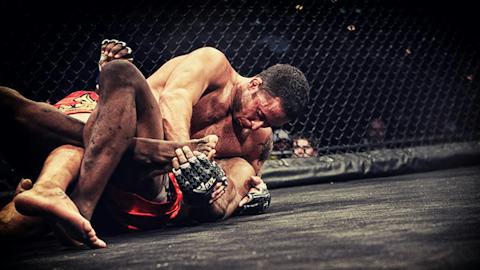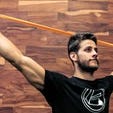In my gym, it is a reoccurring theme to have Thai boxers coming to me with shoulder pain. Without a doubt in my mind, this is from an over emphasis on pressing actions, I.E. punching and pressing.
 These shoulder issues are not exclusive to Thai boxers. Brazilian Jiu-Jitsu athletes come to me with a number of shoulder ailments as they try ever more imaginative methods to try to pull each others arms off. If only they would learn to tap a second earlier, my job wouldn’t be so difficult!
These shoulder issues are not exclusive to Thai boxers. Brazilian Jiu-Jitsu athletes come to me with a number of shoulder ailments as they try ever more imaginative methods to try to pull each others arms off. If only they would learn to tap a second earlier, my job wouldn’t be so difficult!
So, when these athletes come into a strength and conditioning session, I have to do my best to create well-balanced shoulders which can better handle the rigours of training for combat sports. While at the same time, ensuring I don’t aggravate them further.
One of the most common issues I see with my athletes are overdeveloped upper traps and anterior delts, as well as shoulder blades which are held out of position.
These are the areas you need to address in the weight room. By reintroducing an athlete to their scapula, while rebuilding the upper and mid back, you can reduce shoulder pain and stave off future injury.
I’ve a deep toolbox of exercises I use with my athletes, but I almost always start with scapular mobility through lower trap and rhomboid activation. I do this by taking a look into their breathing patterns.
Shoulder Pain Exercise #1: Breathing
I know it is not an exercise in the truest since of the word, but why breathing? Well that’s an article in itself, but lets just say if you are a chest breather, you are likely using muscles designed to lift the shoulder and lower the rib cage. This weakens the shoulders and tightens the neck. Bringing the breath down into the diaphragm allows the neck and shoulders to relax, as well as creating a stronger, deeper and more efficient breath cycle. Less tension in the body AND more oxygen, that can’t a bad!
One of the most successful drills I use for this is a deep squat with the arms elevated. In this position you are holding the “chest breathing” muscles in a shortened position, where they are less likely to pull the ribcage up. This means you are more likely to use the diaphragm correctly, and as you learn to pull the breath deeper into the body you will feel the abdomen expand out, pressing into the thighs giving a tactile feedback.
Shoulder Pain Exercise #2: Resistance Band Pull Aparts
Once the breathing is improved and the traps have had a chance to relax, we need to get the scaps moving and build up the lower traps. For this, there isn’t a more convenient tool than a simple resistance band. If every fighter bought themselves one or two resistance bands and did a few reps every time they trained, their shoulders would be so thankful!
I like to use Resistance Band Pull Aparts, Resistance Band Dislocations, and Resistance Band Overhead Squats, Resistance Band External Rotations and just about anything else you can think to do with a resistance band. Giving an athlete several options is better than just one. The upper back musculature is set up to pull in a multitude of directions, so one exercise will not suffice, and performing one exercise gets rather boring.
I would like to give credit to Tom Furman for showing me this next drill. All I want you to do are 10 pull aparts. Focus on feeling the tension in the lower traps, try to keep the upper traps as relaxed a possible. Pause at the end position of each rep. As soon as you finish the last rep go into dislocations, again for 10 reps. 3 rounds of this should leave your shoulders lose and very warm.
Shoulder Pain Exercise #3: Resistance Band Chest Stretch
Next , open up the chest by attaching the band to an anchor point at shoulder height or just above. Hold the band in the “dog lead grip” so the hand is as relaxed as possible and walk out until the band is tractioning the arm.
Now, roll the shoulder back and down while turning away from the band. This should put a stretch on the pec. If you feel it primarily in the front of the shoulder, you probably haven’t rolled it back and down enough.
With the other arm, reach out and back, keep the palm up and inhale as you reach. Feel the stretch come on and release as you move, this is NOT a static stretch, this is all done in motion, albeit a slow and controlled motion.
Shoulder Pain Exercise #4: Resistance Band Chest Stretch
Now let’s add in some loaded movements. A standard warm up drill for most of the athletes would be the Handcuff drill. This is commonly given out by physiotherapists, but I’ve also seen it on Joe DeFranco’s youtube channel. If Joe uses it, so should you.
Simply take the hands from a handcuff position behind your back and bring them round to touch in front of the head. Do not let them touch the floor. Move slowly in a controlled manner, adding weight as you get stronger. 10-15 reps is plenty.
Shoulder Pain Exercise #5: Scap Pull to Inverted Row
And now, one of my all time favorite drills for building an upper back that supports the shoulders and keeps them safe. It’s a Scap Pull to Inverted Row performed on a suspension trainer.
I insist on using a suspension kit of some kind, as I want the arms to have the ability to rotate freely through the movement. As the scaps become more mobile (as a result of better muscle activation) the arms will rotate more and more through the movement. Using a fixed object such as a smith machine would reduce the movement available.
To start, get into a standard inverted row set up, don’t go as deep as you usually would. Let the shoulders round, sink the chest and feel the upper back stretch. Once you hit the end range of this stretch position, pull the shoulder blades back together, lifting the chest out as you do. Keep the arms straight as you do this. It’s completely normal for this to feel strange, unfamiliar or to have limited range of motion here.
Now, lower under control back to that stretch position. Then repeat the movement, when you’ve retracted the scaps as far as possible, keep pulling, bending the arms as you pull yourself up. Don’t lose tension in the upper back and don’t allow the upper traps to take over.
It’s common for people to roll their shoulder forwards at the top of this lift, if this happens to you (you will need someone else to watch you or set up a video) don’t worry about going full range. Ideally I’d like your hands to finish in your armpits, but for many I only allow them to lift as far as the upper arm coming parallel to the torso. Only increase range of motion as strength and mobility allow.
The inverted row is a top movement for upper back strength, adding the scap pull turbo charges it and builds a back that moves well. And a back that is strong and mobile supports the shoulder, giving it the best chance to generate and resist force while keeping its integrity. I’ll follow this article up with further training ideas we use to develop the most bullet proof shoulders you possibly can. Till then, train hard and train safe.

)





